Analysis Models - Admin & Config - Tabular Model Details¶
This page provides detail information about available Tabular Model specific client functionality in IFS Cloud.
Tabular Models¶
General¶
From the Tabular Models overview page, select one or more models to navigate to the Tabular Model details page.
Tabular Model Detail Page¶
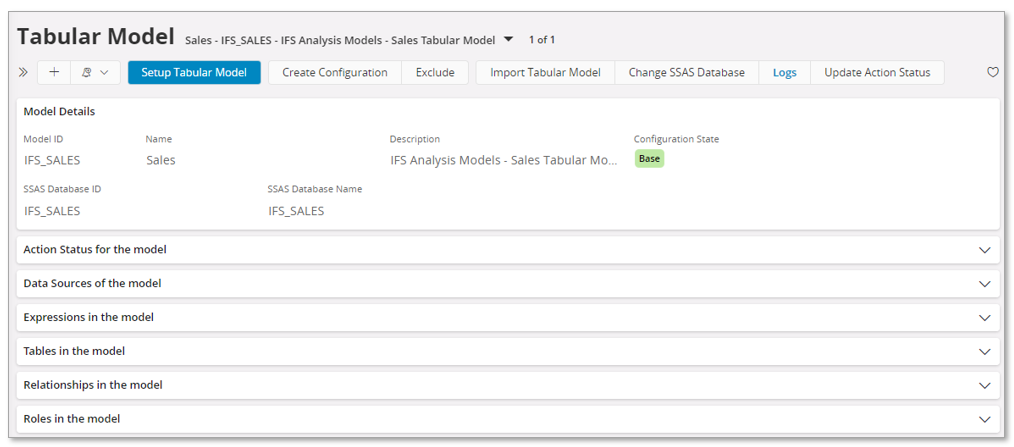
The Model Details page has the same attributes/fields as the overview page but also shows associated model details as lists. Details are Action Status, Data Sources, Expressions, Tables, Relationships and Roles.
The Model Details page provides almost the same commands as the overview page. The following commands are specific for the details page:
| Command | Description |
|---|---|
| Logs | Navigates to the Import Logs page. |
| Update Action Status | The command will try to update the status of each tabular model action correctly. The status of different actions depend on chosen assistant/dialog to perform an action, if access views have been created from the Information Source page or from the Setup Tabular Model assistant etc. This means that the status might not always be accurate. |
Action Status for the model¶
This detail group lists the status for each tabular model action.

| Field | Description |
|---|---|
| Model Action | Name of an Tabular Model related setup action. |
| Action Status | Status of an action. Not Done - Action has not yet been performed. Ongoing - Action is now running/executing. Success - Action execution ended successfully. Error - Action execution ended with an error. Unknown - Action status is not known. Partly - Action has partly been executed. One of the create views actions and all other actions have to be successful to make the model action to indicate Success. |
| User ID | Identity of user that performed the action. |
| Status Change Date | Timestamp when the action was performed. |
| Last Data Load Definition ID | Identity of the last executed data load definition that contains all tabular data sources referenced by the model. |
| Last Data Load Run ID | Identity of the last data load run related to Last Data Load Definition ID |
| Last Data Load Run Exec Time | Time when the Last Data Load Run ID ended. |
| Command | Description |
|---|---|
| Reset Action Status to Unknown | Sets the status of a tabular model action to Unknown. This command can be used in cases when it is clear that the displayed status is incorrect e.g., the status is Ongoing due to that an error occurred during action execution and it was not possible to correctly set the status to Error. |
Data Sources in the model¶
This detail group lists all data sources referenced by the model.
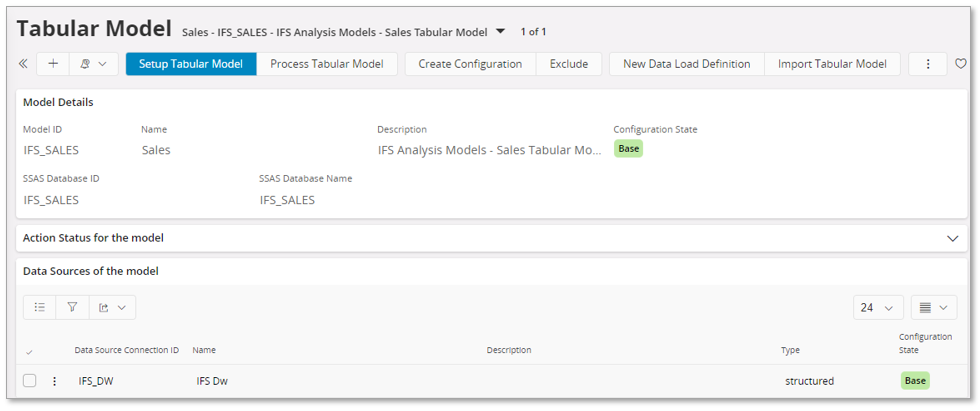
| Field | Description |
|---|---|
| Data Source Connection ID | Identity of the data source connection. IFS_DW represents IFS Cloud. |
| Name | The name of the of the source connection in the model. |
| Description | Description of the data source connection. |
| Type | Data source connection type. |
| Configuration State | The configuration state of the expression. An expression can have its own configuration, i.e. a child configuration of the Tabular Model. For more information, please refer to Custom Configurations. |
Go to details to view the data source connection details.

Expressions in the model¶
This detail group lists all expressions in the model.
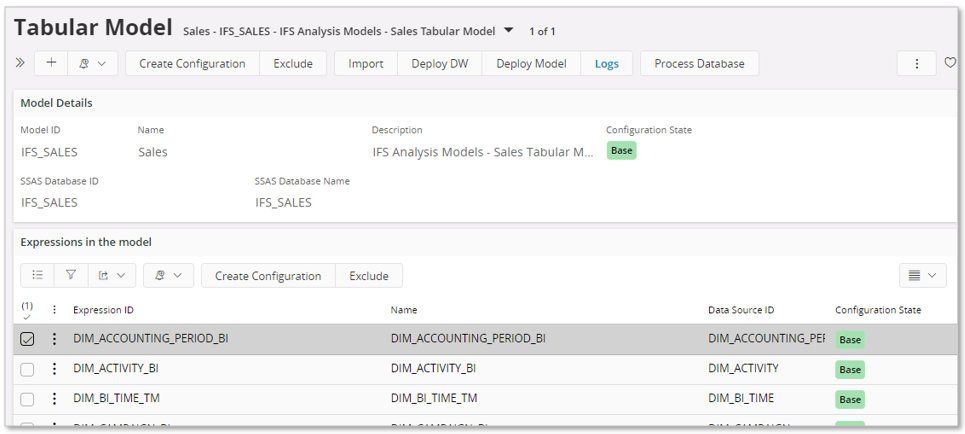
| Field | Description |
|---|---|
| Expression ID | The IFS identity of the expression in current model ( Model ID ) |
| Name | The name of the of the expression. |
| Data Source ID | Identity of Tabular Data Source that specifies the expression source. |
| Configuration State | The configuration state of the expression. An expression can have its own configuration, i.e. a child configuration of the Tabular Model. For more information, please refer to Custom Configurations. |
The Expressions in the model group provides the following commands for a single expression:
| Command | Description |
|---|---|
| Create Configuration | Available if the Configuration State is Base. Will define the expression as configured by setting Configuration State as Configured. It is now possible to configure the expression. |
| Remove Configuration | Removes the expression configuration and sets the Configuration State to Base. |
| Exclude | Excludes the expression or the customization of the expression from deployment. Leads to a Configuration State change. |
| Include | Includes the expression in deployment, typically moving from Excluded to Base or from Configured or Dependent to Base. |
Tables in the model¶
This detail group lists all tables in the model.

| Attribute | Description |
|---|---|
| Table ID | The IFS identity of the table in current model ( Model ID ) |
| Name | The name of the of the table. |
| Reference Expression ID | Identity of expression that the source refers to. |
| Reference Table ID | Identity of table that the source refers to. |
| Data Source ID | Identity of Tabular Data Source that specifies the table source. |
| Configuration State | The configuration state of the table. An table can have its own configuration i.e. a child configuration of the Tabular Model. For more information, please refer to Custom Configurations. |
The Tables in the model group provides the following commands for a single table:
| Command | Description |
|---|---|
| Create Configuration | Available if the Configuration State is Base. Will define the table as configured by setting Configuration State as Configured. It is now possible to configure the table (details). |
| Remove Configuration | Removes the table configuration and sets the Configuration State to Base. |
| Exclude | Excludes the table or the customization of the table from deployment. Leads to a Configuration State change. |
| Include | Includes the table in deployment, typically moving from Excluded to Base or from Configured or Dependent to Base. |
| Process Table | Starts the Tabular Model Processing Assistant that provides the possibility to process the current table but also to process a number of tables or the complete model. |
Relationships in the model¶
This detail group lists all relationships in the model.
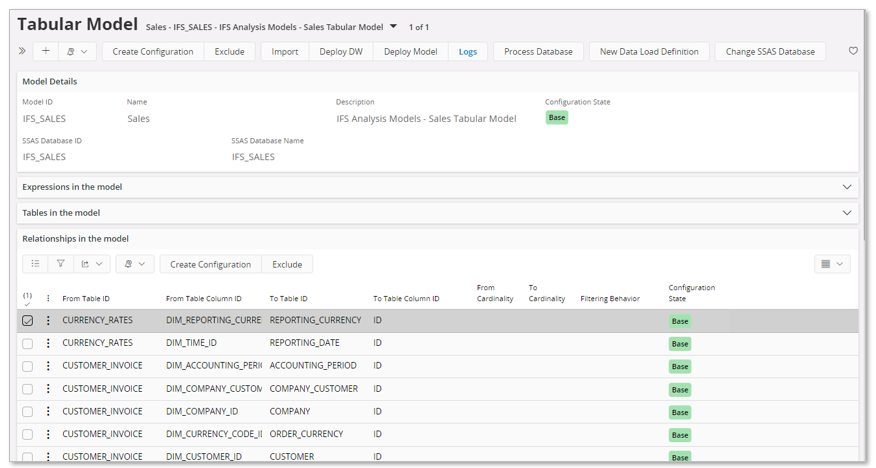
| Attribute | Description |
|---|---|
| From Table ID | The IFS identity of the from table in a table relation in current model ( Model ID ) |
| From Table Column ID | The IFS identity of the from table column in a table relation |
| To Table ID | The IFS identity of the to table in a table relation in current model ( Model ID ) |
| To Table Column ID | The IFS identity of the to table column in a table relation |
| From Cardinality | Cardinality in the from table, e.g. many in a many-to-one relationship |
| To Cardinality | Cardinality in the to table, e.g. one in a many-to-one relationship |
| Filtering behavior | Indicates how relationships influence filtering of data. Typically OneDirection, BothDirections, Automatic |
| Configuration State | The configuration state of the relationship. For more information, please refer to Custom Configurations. |
The Relationships in the model group provides the following commands for a single relationship:
| Command | Description |
|---|---|
| Create Configuration | Available if the Configuration State is Base. Will define the relationship as configured by setting Configuration State as Configured. It is now possible to configure the relationship. |
| Remove Configuration | Removes the relationship configuration and sets the Configuration State to Base. |
| Exclude | Excludes the relationship or the customization of the relationship from deployment. Leads to a Configuration State change. |
| Include | Includes the relationship in deployment, typically moving from Excluded to Base or from Configured or Dependent to Base. |
Roles in the model¶
This detail group lists all roles defined for the model.

Model roles are normally defined in SSMS (SQL Server Management Studio) and specifies the permissions applicable for the role, included members and table specific filters. If roles are added to a base model in SSMS, then when importing the model to IFS Cloud the role definitions will be defined as a configuration.
The other way to handle roles is to use the Aurena client and to create a configuration of a base model, then defining the role definitions and finally deploying the configured model to SSAS.
One example is the GL Model that has a predefined role definition. It contains Table Permissions related to GL Company, Business Plan and Planning Unit users. The role definition will be added in SSAS when deploying the model. Role Members can be added either in Aurena client or in SSMS after having deployed the model.
| Attribute | Description |
|---|---|
| Name | The name of the role as defined in SSMS (SQL Server Management Studio). |
| Description | Description of the role. |
| Model Permission | Role permission. Can be one of the following. Administrator Members can make modifications to the model schema and can query all data in the model designer, reporting client, and SSMS. Row filters do not apply. All data can be queried in this role. None Members cannot make any modifications to the model database schema and cannot query data. Row filters do not apply. No data is visible to users in this role. Read Members are allowed to query data (based on row filters) but cannot see the model database in SSMS, cannot make any changes to the model database schema, and the user cannot process the model. Row filters can be applied. Only data specified in the row filter DAX formula is visible to users. Read Refresh Members are allowed to query data (based on row-level filters) and run process operations by running a script or package that contains a process command, but cannot make any changes to the database. Cannot view the model database in SSMS. Row filters can be applied. Only data specified in the row filter DAX formula can be queried. Refresh Members can run process operations by running a script or package that contains a process command. Cannot modify the model database schema. Cannot query data. Cannot query the model database in SSMS. Row filters do not apply. No data can be queried in this role. |
| Configuration State | The configuration state of the role. An role can have its own configuration, i.e. a child configuration of the Tabular Model. For more information, please refer to Custom Configurations. |
The Roles in the model group provides the following commands for a single role:
| Command | Description |
|---|---|
| Create Configuration | Available if the Configuration State is Base. Will define the role as configured by setting Configuration State as Configured. It is now possible to configure the role. |
| Remove Configuration | Removes the role configuration and sets the Configuration State to Base. |
| Exclude | Excludes the role or the customization of the role from deployment. Leads to a Configuration State change. |
| Include | Includes the role in deployment, typically moving from Excluded to Base or from Configured or Dependent to Base. |
Tabular Table Detail Page¶
From the Tables in the model group in the Tabular Model page, select a table and go to details to navigate to the Tabular Table page. This page provides detail information about:
- Partitions in the table
- Columns in the table
- Measures in the table
- Hierarchies in the table
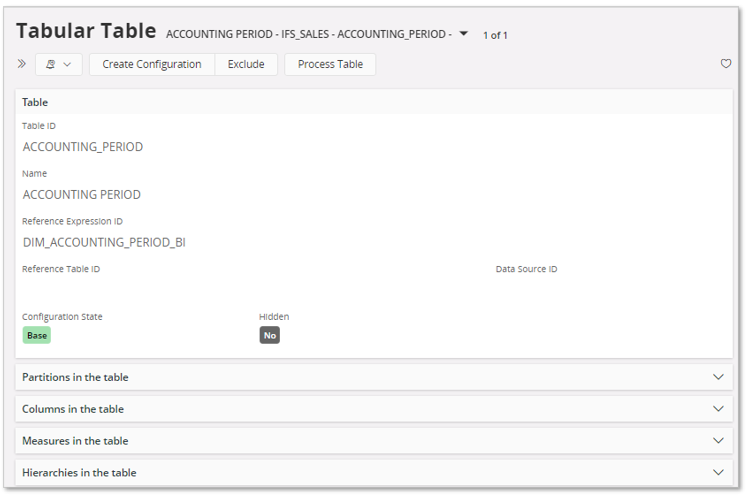
The Table group in the detail page has the same attributes and actions as in the Tables in the model group in the Tabular Model detail page.
Partitions¶
The Partitions in the table list shows all partitions in the table. Currently only one partition per table is supported.

| Attribute | Description |
|---|---|
| Partition ID | The IFS identity of the table partition. |
| Name | Name of the partition. |
| Description | Description of the partition. |
| Data Source | Identity of the Tabular Data Source that specifies the table source. |
| Source Type | The type of source used by this partition. Most common type is m which refers to that the partition is using an M expression. For other values, please refer to Microsoft documentation. |
| Configuration State | The configuration state of the table partition. For more information, please refer to Custom Configurations. |
Available commands for table partition.
| Command | Description |
|---|---|
| Create Configuration | Available if the Configuration State is Base. Will define the table partition as configured by setting Configuration State as Configured. It is now possible to configure the table partition. |
| Remove Configuration | Removes the table partition configuration and sets the Configuration State to Base. |
| Exclude | Excludes the table partition from deployment. Leads to a Configuration State change. |
| Include | Includes the table partition in deployment, typically moving from Excluded to Base. |
Columns¶
The Columns in the table group shows all columns in a table.

| Attribute | Description |
|---|---|
| Column ID | The IFS identity of the table column |
| Name | Name of column |
| Description | Description of column |
| Data Type | Column data type |
| Display Folder | Name of display folder that column should appear in |
| Hidden | Yes if the column should be hidden in client tools. |
| Source Column | Name of the column in the referenced source. |
| Sort By Column | Name of the table column used for sorting. |
| Expression | DAX expression for a calculated column |
| Configuration State | The configuration state of the table column. A table column can have its own configuration, i.e. a child configuration of the tabular table/model. For more information, please refer to Custom Configurations. |
Available commands for table column.
| Command | Description |
|---|---|
| Create Configuration | Available if the Configuration State is Base. Will define the table column as configured by setting Configuration State as Configured. It is now possible to configure the table column |
| Remove Configuration | Removes the table column configuration and sets the Configuration State to Base. |
| Exclude | Excludes the table column from deployment. Leads to a Configuration State change. |
| Include | Includes the table column in deployment, typically moving from Excluded to Base. |
Measures¶
The Measure in the table group shows all measures in a table. Applies to tables based on Facts. (note that the below image is not relevant for the shown tabular table detail.)

| Attribute | Description |
|---|---|
| Measure ID | The IFS identity of the table measure |
| Name | Name of measure |
| Description | Description of measure |
| Display Folder | Name of display folder that measure should appear in |
| Hidden | Yes if the measure should be hidden in client tools. |
| Expression | The DAX expression for the measure |
| Format String | Format string that applies |
| Configuration State | The configuration state of the table measure. A table measure can have its own configuration, i.e a child confguration of the tabular table/model. For more information, please refer to Custom Configurations. |
Available commands for table column.
| Command | Description |
|---|---|
| Create Configuration | Available if the Configuration State is Base. Will define the table measure as configured by setting Configuration State as Configured. It is now possible to configure the table measure |
| Remove Configuration | Removes the table measure configuration and sets the Configuration State to Base. |
| Exclude | Excludes the table measure from deployment. Leads to a Configuration State change. |
| Include | Includes the table measure in deployment, typically moving from Excluded to Base. |
Hierarchies¶
The Hierarchies in the table group shows all hierarchies in a table.

| Attribute | Description |
|---|---|
| Hierarchy ID | The IFS identity of the table hierarchy |
| Name | Name of hierarchy |
| Description | Description of the hierarchy |
| Display Folder | Name of the folder that will contain the hierarchy |
| Hidden | Yes if the hierarchy should be hidden in client tools. |
| Configuration State | The configuration state of the table hierarchy. A table hierarchy can have its own configuration, i.e. a child configuration of the tabular table/model. For more information, please refer to Custom Configurations. |
Tabular Role Detail Page¶
From the Roles in the model group in the Tabular Model page, select a role and go to details to navigate to the Tabular Role page. This page provides detail information about:
- Table Permissions
- Role Members
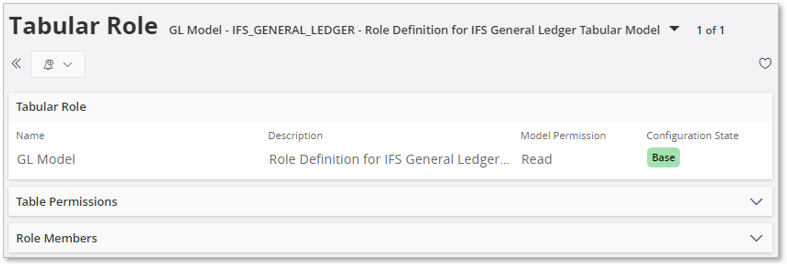
The Table Permissions list shows the filter expression that will be applied to a table in the model. These filters are mainly used to support RLS (Row Level Security).

| Attribute | Description |
|---|---|
| Table | The IFS identity of a table in the model with an associated filter expression that is used to control table permissions. |
| Filter Expression | A DAX expression used as a table filter to control table permission. The filter is typically used for handling of RLS, where members of the role gets access to different table details. The filter expression normally includes a DAX function to retrieve the user identity. This function should in most cases be the USERPRINCIPLENAME(), a function that return the user principle name. If the USERNAME() function is used the user identity is often a domain user. It is important to make sure that the correct function is applied. The result of the user function must return a user name that is defined as AD User Identity in the AD User Mappings page. |
| Configuration State | The configuration state of the role permission. For more information, please refer to Custom Configurations. |
Available commands for role permissions.
| Command | Description |
|---|---|
| Create Configuration | Available if the Configuration State is Base. Will define the role permission as configured by setting Configuration State as Configured. It is now possible to configure the role permission. |
| Remove Configuration | Removes the role permission configuration and sets the Configuration State to Base. |
| Exclude | Excludes the role permission from deployment. Leads to a Configuration State change. |
| Include | Includes the role permission in deployment, typically moving from Excluded to Base. |
The Role Members list shows the members of the role.

| Attribute | Description |
|---|---|
| Member Name | The identity of a role member. If the member is a user then it should be related to the AD User Identity on the AD User Mappings page. When defined via Aurena, only users defined in the AD User Mappings page will be possible to choose. Upon save the related Fnd User identity will be displayed. During import of a model for which the role definitions have been handled in SSMS, it might be so that the Member Name is not recognized. In this case the Fnd User will not be displayed. When this happens,please make sure to update the mappings on the AD User Mappings' page. |
| Fnd User | This is the IFS user identity. Mappings of valid users is made on the AD User Mappings page. This is a read-only field. |
| Identity Provider | The name of the provider that handles user identification. Not a mandatory field. Will in most cases only have a value after import of a role defined in SSMS. |
| Member Type | Defines the member type. Auto Group The member is a user group, typically an AD group. User The member is a user, typically an AD user. Not a mandatory field. Will in most cases only have a value after import of a role defined in SSMS. |
Note: Adding or removing members from role is not considered as a configuration.
More Information¶
Use the following links for more information about administration and configuration of Tabular Models: